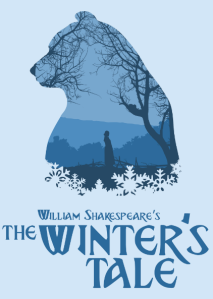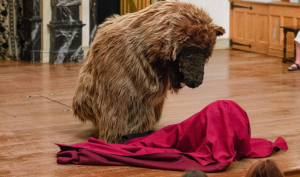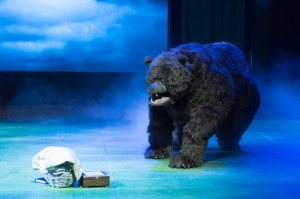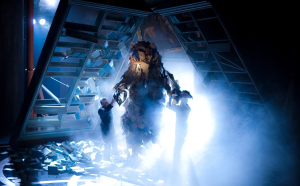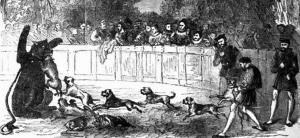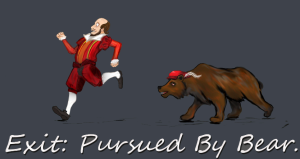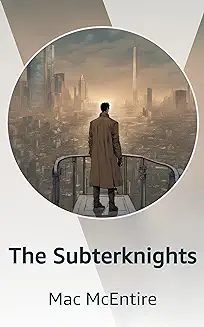Re-reading Shakespeare’s The Winter’s Tale! It’s the moment we’ve all been waiting for, in which Antigonus will… exit, pursued by a bear!!!
Where were we? Antigonus has left the baby Perdita in the woods, after a speech about the ghost of her mother, Queen Hermoine, and about how he believes he is doomed and that, “The chase is on.” Then we get the famous stage direction:
[He exits, pursued by a bear]
At least, the Folger edition says, “He exits,” while the Oxford and Pelican editions just state the more commonly quoted, “Exit.” The difference is small, but it’s noteworthy because The Winter’s Tale has the distinction of more descriptive stage directions that Shakespeare’s other plays. This is likely because the play was not written for the outdoor Globe Theater, but for Blackfriars, a smaller indoor theater that gave Shakespeare more control over lighting and effects.
That brings us to the big question: How is this to be portrayed on stage? For a more low-budget production, the answer can be to light a silhouette of a bear shape onto the wall. Or, failing that, just have a bear’s roar come from backstage. You could always have an actor in a Halloween store bear costume run across the stage, but that could make this harrowing scene unintentionally humorous. Then again, The Winter’s Tale is listed among Shakespeare’s comedies, so if you’re going very, very broad with it all, then a cheesy bear suit could elicit intentional laughs. Others have taken a more abstract interpretation, by having dancers in bear masks surround Antigonus, for a balletic and/or pageantry take on the scene.
If you have money to spend, there’s all sorts of ways to do the bear. You find lots of images online of elaborate bear puppets constructed for this scene, some of them very scary looking. Some are designed to move realistically, while others are more abstract, rising from under the floor until they look gigantic, towering over the helpless Antigonus. And obviously, a movie version can go nuts with production value and special effects, creating huge bear attacks like the ones in The Edge or The Revenant.
There are more. A 2018 Globe production brought out an oversized bear skull on stage to have it represent the animal. Another version from 2009 replaced the bear with a ghostly creature made entirely of pages from torn books. I’m not quite sure what the symbolism is there (representing the collapsing of Leontes’ kingdom, perhaps?) but it’s a striking visual. In a 1976 Royal Shakespeare Company production, the bear was replaced with Father Time, who we’ll meet a few scenes from now. By having Time himself kill Antigonus, it emphasizes the inevitability of Antigonus’ forewarned death.
The next question is, what about putting a real bear on stage? That leads us into places rather ghoulish. In Shakespeare’s time, so-called “bear-baiting” was a semi-popular form of entertainment. A captured bear was put into a pit with a bunch of hungry attack dogs. Crowds would delight in the bloody violence as the animals battled it out. Allegedly, both King Henry VIII and Shakespeare’s BFF Queen Elizabeth were fans of bear-baiting. This crossed over with live theater, as traveling acting troupes would include bear pits alongside their comedies and tragedies. All the academic Shakespeare blogs and sites I follow are quick to point out that there’s “no evidence” of Shakespeare using a real bear in The Winter’s Tale, and that it “probably” never happened. This careful wording, however, suggests there’s some possibility that it might have happened. Despite everything we know about Shakespeare, there’s still a lot we don’t know, which part of why we still talk about him today.
And a bigger picture question: Why are people so drawn to this one stage direction? On the page, this adds a burst of excitement after the long trial scene. But in modern times, “exit pursued by a bear” has become something of a comedy punchline, shorthand for anything random or unexpected. I don’t believe it is random, because the scene leading up to this establishes that Antigonus is in a harsh wilderness, and that he believes he is doomed. Beyond that, though, I can’t fully explain it. When people think of The Winter’s Tale, they think “It’s the one with the bear.” Nothing wrong with that.
Next: My son the clown.
* * * *
Want more? Check out my ongoing serial, THE SUBTERKNIGHTS, on Kindle Vella. A man searches for his missing sister in a sprawling city full of far-out tech, strange creatures, and secret magic. It’s a sci-fi/fantasy hybrid full of action, romance, mystery, and laughs. The first ten episodes are FREE! Click here for a list of all my books and serials.

